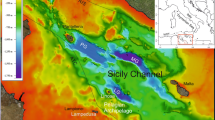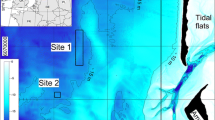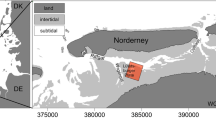Abstract
Marine habitats of shelf seas are in constant dynamic change and therefore need regular assessment particularly in areas of special interest. In this study, the single-beam acoustic ground discrimination system RoxAnn served to assess seafloor hardness and roughness, and combine these parameters into one variable expressed as RGB (red green blue) color code followed by k-means fuzzy cluster analysis (FCA). The data were collected at a monitoring site west of the island of Helgoland (German Bight, SE North Sea) in the course of four surveys between September 2011 and November 2014. The study area has complex characteristics varying from outcropping bedrock to sandy and muddy sectors with mostly gradual transitions. RoxAnn data enabled to discriminate all seafloor types that were suggested by ground-truth information (seafloor samples, video). The area appears to be quite stable overall; sediment import (including fluid mud) was detected only from the NW. Although hard substrates (boulders, bedrock) are clearly identified, the signal can be modified by inclination and biocover. Manually, six RoxAnn zones were identified; for the FCA, only three classes are suggested. The latter classification based on ‘hard’ boundaries would suffice for stakeholder issues, but the former classification based on ‘soft’ boundaries is preferred to meet state-of-the-art scientific objectives.









Similar content being viewed by others
References
Bartholomä A (2006) Acoustic bottom detection and seabed classification in the German Bight, southern North Sea. Geo-Mar Lett 26:177–184
Bezdek JC (1974) Numerical taxonomy with fuzzy sets. J Math Biol 1:57–71
Bezdek JC, Ehrlich R, Full W (1984) FCM The fuzzy c-means clustering algorithm. Comput Geosci 10:191–203
Brekhovskikh LM, Lysanov IP, Lysanov YP (2003) Fundamentals of ocean acoustics. Springer, Berlin
Brown CJ, Smith SJ, Lawton P, Anderson JT (2011) Benthic habitat mapping: a review of progress towards improved understanding of the spatial ecology of the seafloor using acoustic techniques. Estuar Coast Shelf Sci 92:502–520
BSH (2016) Anleitung zur Kartierung des Meeresbodens mittels hochauflösender Sonare in den deutschen Meeresgebieten. BSH Nr. 7201, 148 pp
Budiman (2003) http://www.mathworks.com/matlabcentral/ fileexchange/4353-fuzzy-k-means/content/contents.m
Burrough PA, van Gaans PFM, Hootsmans RJ (1997) Continuous classification in soil survey: spatial correlation, confusion and boundaries. Geoderma 77:115–135
Callies U, Plüß A, Kappenberg J, Kapitza H (2011) Particle tracking in the vicinity of Helgoland, North Sea: a model comparison. Ocean Dyn 61(12):2121–2139
Calvert J, Strong JA, McGonigle C, Quinn R (2015) An evaluation of supervised and unsupervised classification techniques for marine benthic habitat mapping using multibeam echosounder data. ICES J Mar Sci 72(5):1498–1513
Chang TS, Bartholomä A, Flemming BW (2006) Seasonal dynamics of fine-grained sediments in a back-barrier tidal basin of the German Wadden Sea (Southern North Sea). J Coast Res 22:328–338
Chivers RC, Emerson N, Burns DR (1990) New acoustic processing for underway surveying. Hydrogr J 56:8–17
Cholwek G, Bonde J, Li X, Richards C, Yin K (2000) Processing RoxAnn sonar data to improve its categorization of lake bed surficial substrates dagger. Mar Geophys Res 21:409–421
Cogan CB, Todd BJ, Lawton P, Noji TT (2009) The role of marine habitat mapping in ecosystem-based management. ICES J Mar Sci 66(9):2033–2042
Daniell J, Siwabessy J, Nichol S, Brooke B (2015) Insights into environmental drivers of acoustic angular response using a self-organising map and hierarchical clustering. Geo-Mar Lett 35:387–403. doi:10.1007/s00367-015-0415-5
Dean BJ, Ellis JT, Irlandi E (2013) Measuring nearshore variability in benthic environments: an acoustic approach. Ocean Coast Manag 86:33–41
Diesing M, Green SL, Stephens D, Lark RM, Stewart HA, Dove D (2014) Mapping seabed sediments: Comparison of manual, geostatistical, object-based image analysis and machine learning approaches. Cont Shelf Res 84:107–119
Ferrini VL, Flood RD (2006) The effects of fine-scale surface roughness and grain size on 300 kHz multibeam backscatter intensity in sandy marine sedimentary environments. Mar Geol 228(1):153–172
Figge K (1981) Karte zur Sedimentverteilung in der Deutschen Bucht im Maßstab 1: 250000. Deutsches Hydrographisches Institut Nr 2900
Foster-Smith RL, Davies J, Sotheran I (2000) Broad scale remote survey and mapping of subtidal habitats and biota. Technical report of the Broadscale Mapping Project. Edinburgh, Scottish Natural Heritage Research, Survey and Monitoring Report no 167
Foster-Smith RL, Brown CJ, Meadows WJ, White WH, Limpenny DS (2004) Mapping seabed biotopes at two spatial scales in the eastern English Channel. Part 2. Comparison of two acoustic ground discrimination systems. J Mar Biol Assoc UK 84:489–500
Foster-Smith B, Connor D, Davies J (2007) MESH Guide to Habitat Mapping. JNCC, Peterborough. http://www.searchmesh.net
Franke HD, Gutow L (2004) Long-term changes in the macrozoobenthos around the rocky island of Helgoland (German Bight, North Sea). Helgol Mar Res 58(4):303–310
Gavrilov AN, Duncan AJ, McCauley RD, Parnum IM, Penrose JD, Siwabessy PJW, Woods AJ, Tseng YT (2005) Characterization of the seafloor in Australia’s coastal zone using acoustic techniques. In: Proc Int Conf Underwater Acoustic Measurements: Technologies & Results, pp 1075–1080
Goff JA, Olson HC, Duncan CS (2000) Correlation of side-scan backscatter intensity with grain-size distribution of shelf sediments, New Jersey margin. Geo-Mar Lett 20(1):43–49
Greenstreet SP, Tuck ID, Grewar GN, Armstrong E, Reid DG, Wrigh PJ (1997) An assessment of the acoustic survey technique, RoxAnn, as a means of mapping seabed habitat. ICES J Mar Sci 54:939–959
Greenstreet SP, Holland GJ, Guirey EJ, Armstrong E, Fraser HM, Gibb IM (2010) Combining hydroacoustic seabed survey and grab sampling techniques to assess “local” sandeel population abundance. ICES J Mar Sci 67(5):971–984
Hamilton LJ (2001) Acoustic seabed classification systems. Defence Science and Technology Organisation, Victoria (Australia), Aeronautical and Maritime Research Lab no DSTO-TN-0401
Hamilton LJ (2005) A bibliography of acoustic seabed classification. CRC Coastal Zone Estuary and Waterway Management, Technical Report 27
Hamilton LJ, Mulhearn PJ, Poeckert R (1999) Comparison of RoxAnn and QTC-View acoustic bottom classification system performance for the Cairns area, Great Barrier Reef, Australia. Cont Shelf Res 19:1577–1597
Hass HC, Kuhn G, Monien P, Brumsack HJ, Forwick M (2010) Climate fluctuations during the past two millennia as recorded in sediments from Maxwell Bay, South Shetland Islands, West Antarctica. Geol Soc Lond Spec Publ 344:243–260
Hebbeln D, Scheurle C, Lamy F (2003) Depositional history of the Helgoland mud area, German Bight, North Sea. Geo-Mar Lett 23(2):81–90
Henriques V, Guerra MT, Mendes B, Gaudêncio MJ, Fonseca P (2015) Benthic habitat mapping in a Portuguese marine protected area using EUNIS: an integrated approach. J Sea Res 100:77–90
Huang Z, Nichol SL, Siwabessy JPW, Daniell J, Brooke BP (2012) Predictive modelling of seabed sediment parameters using multibeam acoustic data: a case study on the Carnarvon Shelf, Western Australia. Int J Geogr Inf Sci 26:283–307
ICES (2007) Acoustic seabed classification of marine physical and biological landscapes. ICES Cooperative Research Report no 286, pp 1–183
Jagodzinski Z (1960) Multiple echoes in echosounders and the probability of detection of small targets. Int Hydrogr Rev 37:63–68
Kenny AJ, Cato I, Desprez M, Fader G, Schuttenhelm RTE, Side J (2003) An overview of seabed-mapping technologies in the context of marine habitat classification. ICES J Mar Sci 60:411–418
Lucieer V, Lamarche G (2011) Unsupervised fuzzy classification and object-based image analysis of multibeam data to map deep water substrates, Cook Strait, New Zealand. Cont Shelf Res 31(11):1236–1247
Lucieer V, Lucieer A (2009) Fuzzy clustering for seafloor classification. Mar Geol 264(3/4):230–241
Lurton X, Lamarche G (eds) (2015) Backscatter measurements by seafloor‐mapping sonars. Guidelines and recommendations. http://geohab.org/wp‐content/uploads/2014/05/BSWG‐REPORT‐MAY2015.pdf
MacQueen J (1967) Some methods for classification and analysis of multivariate observations. In: Cam LM, Neyman J (eds) Proc 5th Berkeley Symp Mathematical Statistics and Probability. University of California Press, Berkeley, pp 281–297
Mamede R, Rodrigues AM, Freitas R, Quintino V (2015) Single-beam acoustic variability associated with seabed habitats. J Sea Res 100:152–159
McCauley RD, Siwabessy PJW (2006) Practical guide to acoustic techniques for benthic habitat classification. CRC for Coastal Zone, Estuary and Waterway Management, Indooroopilly, Queensland, Australia, Technical Report 84, pp 1–39
Mielck F, Hass HC, Betzler C (2012) High-resolution hydroacoustic seafloor classification of sandy environments in the German Wadden Sea. J Coast Res 30:1107–1117
Mielck F, Bartsch I, Hass HC, Wölfl AC, Bürk D, Betzler C (2014) Predicting spatial kelp abundance in shallow coastal waters using the acoustic ground discrimination system RoxAnn. Estuar Coast Shelf Sci 143:1–11
Ostrovsky I, Tęgowski J (2010) Hydroacoustic analysis of spatial and temporal variability of bottom sediment characteristics in Lake Kinneret in relation to water level fluctuation. Geo-Mar Lett 30:261–269
Papenmeier S, Schrottke K, Bartholomä A (2014) Over time and space changing characteristics of estuarine suspended particles in the German Weser and Elbe estuaries. J Sea Res 85:104–115
Penrose JD, Siwabessy PJW, Gavrilov A, Parnum I, Hamilton LJ, Bickers A, Brooke B, Ryan DA, Kennedy P (2005) Acoustic techniques for seabed classification. CRC for Coastal Zone Estuary and Waterway Management, Technical Report 32, pp 1–130
Richardson MD, Briggs KB, Williams KL, Lyons AP, Jackson DR (2001) Effects of changing roughness on acoustic scattering: (2) anthropogenic changes. In: Leighton TG, Heald GJ, Griffiths G, Griffiths HD (eds) Proc Inst Acoustics 23(2):343–390
Schlagintweit GEO (1993) Real-time acoustic bottom classification for hydrography a field evaluation of RoxAnn. In: OCEANS’93. Engineering in Harmony with Ocean. Proceedings IEEE:III-214
Schmidt-Thomé P (1982) Geologische Karte von Helgoland mit Erläuterungen. Geologisches Jahrbuch A62. Schweizerbart, Stuttgart
Serpetti N, Heath M, Armstrong E, Witte U (2011) Blending single beam RoxAnn and multi-beam swathe QTC hydro-acoustic discrimination techniques for the Stonehaven area, Scotland, UK. J Sea Res 65:442–455
Shumchenia EJ, King JW (2010) Comparison of methods for integrating biological and physical data for marine habitat mapping and classification. Cont Shelf Res 30(16):1717–1729
Snellen M, Siemes K, Simons DG (2011) Model-based sediment classification using single-beam echosounder signals. J Acoust Soc Am 129:2878–2888
Spaeth C (1990) Zur Geologie der Insel Helgoland. Küste 49:1–32
Stanev EV, Al-Nadhairi R, Valle-Levinson A (2015) The role of density gradients on tidal asymmetries in the German Bight. Ocean Dyn 65(1):77–92
von Haugwitz W, Wong HK, Salge U (1988) The mud area southeast of Helgoland: a reflection seismic study. Mitt Geol-Paläontol Inst Univ Hamburg 65:409–422
Voulgaris G, Collins MB (1990) USP RoxAnn ground discrimination system: a preliminary evaluation. ARE Portland UTH Tech Memo 36/90 RE005314, University of Southampton, Marine Consultancy Services Tech Rep no SUDO/TEC/90/5C, pp 1–75
Wilding TA, Sayer MD, Provost PG (2003) Factors affecting the performance of the acoustic ground discrimination system RoxAnn™. ICES J Mar Sci 60(6):1373–1380
Winter C, Herrling G, Bartholomä A, Capperucci R, Callies U, Heipke C, Schmidt A, Hillebrand H, Reimers C, Bremer P, Weiler R (2014) Scientific concepts for monitoring the ecological state of German coastal seas (in German). Wasser und Abfall 07-08/2014:21–26. doi:10.1365/s35152-014-0685-7
Wölfl A-C, Lim CH, Hass HC, Lindhorst S, Tosonotto G, Lettmann KA, Kuhn G, Wolff J-O, Abele D (2014) Distribution and characteristics of marine habitats in a subpolar bay based on hydroacoustics and bed shear stress estimates—Potter Cove, King George Island, Antarctica. Geo-Mar Lett 34:435–446
Acknowledgements
The authors would like to thank Cpt. Robert Voss and his crew of RV Heincke for their help and cooperation during many surveys. We acknowledge the aid of many students in the frame of internships. This study was carried out within the WIMO project (“Scientific Monitoring Concepts for the German Bight”) funded by the Ministry for Environment and Climate Protection and Ministry for Science and Culture of Lower Saxony, Germany. We are grateful to two reviewers and the journal editors for many helpful comments. All data can be downloaded from the PANGAEA data bank (www.pangaea.de).
Author information
Authors and Affiliations
Corresponding author
Ethics declarations
Conflict of interest
The authors declare that there is no conflict of interest with third parties.
Additional information
Responsible guest editor: C. Winter
Electronic supplementary material
Below is the link to the electronic supplementary material.
ESM 1
(PDF 240 kb)
Rights and permissions
About this article
Cite this article
Hass, H.C., Mielck, F., Fiorentino, D. et al. Seafloor monitoring west of Helgoland (German Bight, North Sea) using the acoustic ground discrimination system RoxAnn. Geo-Mar Lett 37, 125–136 (2017). https://doi.org/10.1007/s00367-016-0483-1
Received:
Accepted:
Published:
Issue Date:
DOI: https://doi.org/10.1007/s00367-016-0483-1




